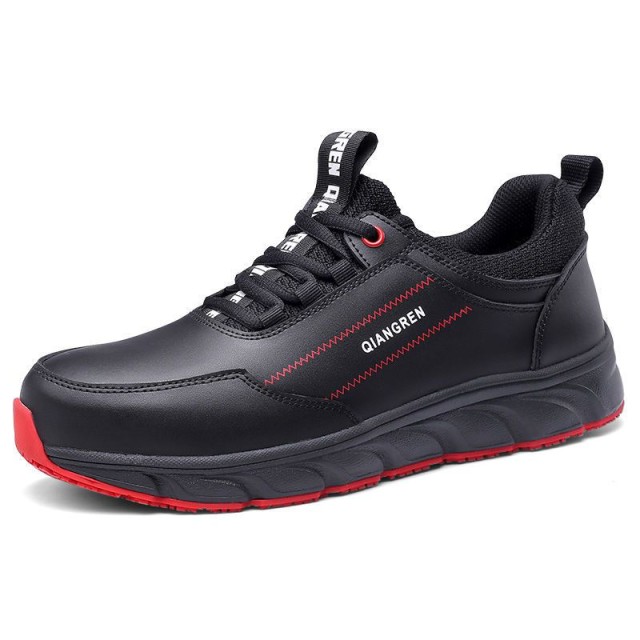For workers in hazardous environments, safety footwear isn't optional—it's a critical layer of protection. But traditional steel toe boots come with trade-offs: weight, conductivity, and temperature extremes. Composite toe boots solve these challenges while meeting strict ASTM and OSHA standards. Here's what professionals need to know about their safety, compliance, and real-world performance.
Composite Toe Materials and Safety Standards
Composite toes use advanced non-metallic materials like carbon fiber, Kevlar, and engineered plastics to create protective caps that rival steel in protection but excel in versatility. These materials must pass the same rigorous ASTM F2413 tests as steel toes, including:
- Impact resistance: Withstands forces equivalent to a 50 lb weight dropped from 4 feet (200J)
- Compression resistance: Protects against up to 2,500 lbs of static pressure
- Electrical hazard protection: Non-conductive materials prevent current transfer
Unlike steel toes, composite materials won't:
✓ Trigger metal detectors (crucial for airports or secure facilities)
✓ Conduct heat/cold to the foot
✓ Create spark risks in flammable environments
Key Insight: Research shows both toe types provide equal protection against crushing forces—the difference lies in their secondary properties.
How Composite Toes Compare to Steel in Protection and Comfort
Protection Parity
- Both meet identical ASTM standards for impact and compression
- Composite materials distribute force differently but achieve the same protective outcome
Comfort Advantages
| Factor | Composite Toe | Steel Toe |
|---|---|---|
| Weight | ~30% lighter | Heavier base weight |
| Temperature | Insulates in cold/heat | Conducts extreme temps |
| Flexibility | More foot mobility | Rigid structure |
A study of warehouse workers found those wearing composite toe boots reported 40% less fatigue after 10-hour shifts compared to steel toe wearers.
Have you considered how boot weight compounds over thousands of steps per shift? Lighter materials reduce cumulative strain.
Ideal Industries and Use Cases for Non-Metallic Safety Toes
Top Applications
- Electrical work: Non-conductive materials prevent electrocution risks
- Cold storage: Thermal insulation maintains foot warmth below freezing
- Airport security: Passes through metal detectors without alarms
- MRI facilities: No magnetic interference with sensitive equipment
OSHA specifically recommends composite toes for:
- Utility workers exposed to live wires
- Food processing plants with washdown requirements
- Chemical handlers where spark resistance matters
Real-World Impact: Welders appreciate that composite toes won't superheat from sparks like steel caps can.
Limitations and Maintenance of Composite Toe Boots
When Steel Might Be Better
- Extreme crushing environments (e.g., foundries with molten metal splash risks)
- Jobs requiring repeated toe impacts (composite may show wear faster)
Care Tips to Maximize Lifespan
- Avoid direct flame exposure (some composites have lower melt points than steel)
- Clean chemicals off promptly to prevent material degradation
- Replace if the cap shows cracks or deformation
Pro Tip: Rotate two pairs to extend longevity—moisture breaks down composites faster than steel.
Step Confidently in OSHA-Compliant Safety
Composite toe boots represent the evolution of workplace foot protection—delivering certified safety without the drawbacks of metal. For distributors and bulk buyers, 3515’s manufacturing expertise ensures every pair meets the exacting demands of modern hazardous workplaces.
Ready to equip your workforce with lighter, safer footwear? Partner with 3515 to source compliant composite toe boots that workers will actually wear—because comfort drives consistent safety compliance.
Related Products
- Customizable Anti-Smash Safety Boots for Wholesale & Private Label Manufacturing
- Wholesale Durable Breathable Safety Boots Custom OEM Manufacturer
- Durable Leather Safety Boots for Wholesale & Custom OEM Manufacturing
- Wholesale Customizable Safety Boots Durable & Protective Footwear Manufacturing
- Wholesale Slip-On Safety Boots Manufacturer - Custom Puncture-Proof & Steel Toe
Related Articles
- Steel-Toe Boot Safety: Separating Fact from Fiction
- Matching Men’s Work Shoe Safety Technologies to Workplace Hazards
- How Steel Toe Shoes Prevent Injuries: The Science Behind Workplace Safety
- How to Choose Safety Footwear That Solves Steel Toe Shoe Problems Without Sacrificing Protection
- How to Reduce Foot Injury Risks in High-Risk Workplaces: 3 Proven Strategies




















